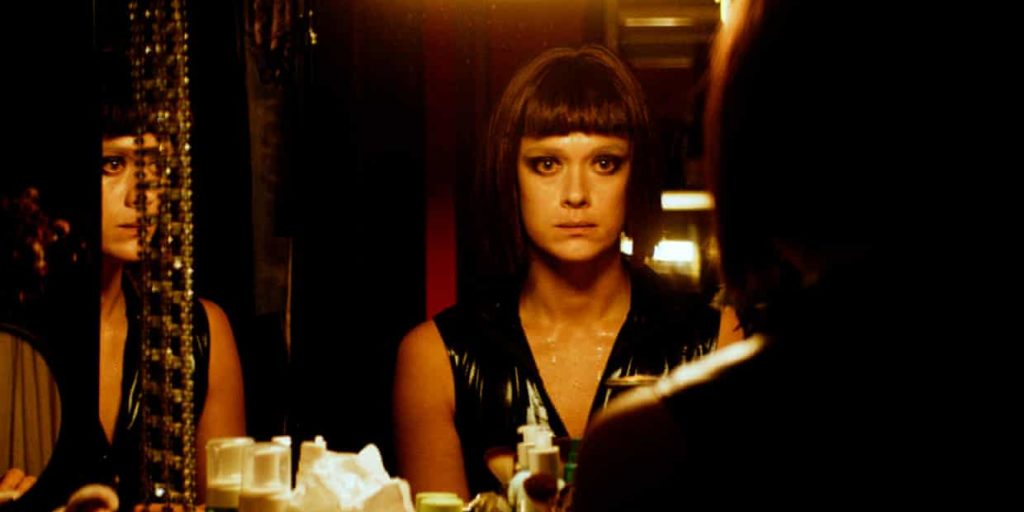For a film about sadomasochism, Dogs Don’t Wear Pants (Koirat eivät käytä housuja) isn’t really about sex. That isn’t to say the Finnish director J-P Valkeapää ignores the eroticism of his subject matter. But this isn’t a love story so much as it’s one about pain, control, and release. It seeks to tap into a primal element of our animal nature from its opening shot of a fish sucking air in the hull of a boat. Before the opening credits even begin, Valkeapää’s protagonist will liken himself as much to that fish as he will to a canine. Mammalian or piscine, our basic need for life is counteracted only by the unnatural impulse to reject it, to wade in a stupor like a melancholic zombie.
That’s certainly an apt description of Juha (Pekka Strang, who resembles a young Peter Weller). He is an open-heart surgeon whose wife tragically drowned in the lake outside their cottage while vacationing with their young daughter Elli (Ellen Karppo). Years have passed, and Juha hasn’t moved on so much as he’s merely compartmentalized his grief while raising a now-teenage Elli (Ilona Huta). He uses tokens of his wife, including a dress and her perfume, for masturbation, though any erotic pleasure is sapped by Juha’s cold, mechanical motions. But this ossification begins to crack upon a chance meeting with a dominatrix named Mona (Krista Kosonen), who operates a dungeon in the basement of a piercing parlor. As Juha accidentally stumbles into her den, she disarms him, pinning him down by the neck with her riding crop for nearly thirty seconds. This visceral encounter is only interrupted by Elli’s arrival after getting her tongue pierced. The car ride home is more than a little awkward.

Yet Juha feels compelled to return to Mona in service of his chief desire; to be strangled to the brink of death, in a morbid re-enactment of his own near-death experience struggling to save his wife. “I know about the heart,” he assures Mona over the phone, an assertion not lacking for irony. Their first session ends with him breaking into sobbing convulsions, but the following day he struts down the hallways of the hospital he works in with a skip in his step. His colleagues can only stare at their peer, one whose stability they gradually come to question.
On paper, Valkeapää’s film is an incredibly risky venture. A lesser movie would have the character of Mona reduced to the S&M equivalent of a manic pixie dream girl, or her subcommunity depicted in exploitative flourishes of sensationalized set pieces. But the script, by Valkeapää and Juhana Lumme, eschews most of these pitfalls to probe the limits of pain in oddly sensitive ways. That isn’t to say the film coddles the audience. Moments of frank, though not overly graphic, degradation will perturb the squeamish, with one sequence toeing the line in its blunt violence. But the film confidently implements momentary interludes of pitch-black comedy which never undermine the severity of the story’s emotional stakes.

This delicate subjectivity finds its apex in the film’s finest scene, where Elli performs at a school event Juha neglects to attend due to his growing obsession with Mona. The sequence crosscuts between Juha and Mona’s session and the performance of And Then He Kissed Me at the high school. The lead singer, a teenage boy, changes the lyrics to “And Then I Kissed Her” whilst still performing in English. This small detail reinforces what that famous tracking shot from Goodfellas expressed: the pop staple by The Crystals was never about first love as much as it was about masculine power. Valkeapää slyly subverts this reading through Juha’s submissiveness whilst acknowledging the rage and disappointment he incurs in his daughter, her own brash beat of the drums expressing her otherwise latent grief.
This disarming wealth of empathy guides the film’s various social circles toward a feeling of self-acceptance without sexual stigmatization. All three of the chief characters experience this, with Juha receiving the greatest focus. But the film also offers a measured view of Elli’s own adolescent struggles when her newly implemented tongue piercing is mocked by some teenage boys as perfect for “blow jobs”. As for Mona, she prides herself on maintaining the physical and emotional well-being of her patrons, both in her dungeon and during her day job as a physical therapist. The allure of S&M for her is summarily explained with the simple proclamation, “I don’t like ordinary stuff.” It is this drive which finds an unhealthy instigator in Juha’s dogged determination for self-destruction.

Indeed, Juha’s morbidity informs DP Pietari Petola’s gray color palette, interrupted by the flashes of neon reds, hot pink, and faint traces of green ushering us into Mona’s dungeon. Even her apartment is uniform yet not ostentatious, a marked contrast to Juha’s sleek, industrialized domicile. While there is certainly an element of class difference between the characters, the film thankfully doesn’t pursue this to pedantic ends. Rather, the chief dichotomy in Dogs Don’t Wear Pants is one between the pursuit of myopic gratification and a consensual embrace of another person’s needs. In this respect, the film is wholly supportive of the S&M scene without ever deigning to sentimentalize or cheapen it for a mass audience. This lends the closing passages an emotional acuity that is life-affirming while staying true to the film’s own inimitable, iconoclastic elan. In this respect, Dogs Don’t Wear Pants truly approximates the psychic effect of S&M as a painful experience which leaves you feeling good.
